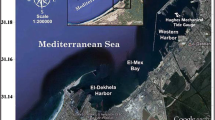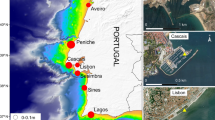Abstract
This study investigates extreme sea level variations recorded by tide gauges in the coastal regions of the Sea of Japan during the passage of the typhoons Maysak and Haishen in September 2020. Specific focus is on storm surges, seiches and infragravity waves (IG waves) identified in the time series using tidal and statistical analyses. In most cases, storm surges formed through the combined effect of atmospheric pressure changes and strong winds were the major contributors to the extreme sea level rise. The first typhoon, Maysak, was the most significant in strength at the Russian and Japanese coasts, while the largest sea level variations at the southeastern coast of the Korean Peninsula were caused by the second cyclone Haishen. At all sites, the passing storms generated eigen oscillations in bays and harbors. The maximum range of high-frequency oscillations with periods of two to seven minutes, caused by IG waves, was recorded in Preobrazheniye and amounted to 2 m. The observed differences in sea level variations arise from differences in the topographic features of the corresponding coastal sites. Statistical analysis of the atmospheric pressure and wind speed series from weather stations and from the ERA5 reanalysis shows that the atmospheric pressure is reproduced by the reanalysis with high accuracy, whereas the wind speed at different stations has significant discrepancies related to the differences in local features of specific areas.







Similar content being viewed by others
Notes
Typhoon is the term used for tropical cyclones that form in the Northwest Pacific [2].
IOC = Intergovernmental Oceanographic Commission UNESCO.
REFERENCES
Hydrometeorology and Hydrochemistry of the Seas, Vol. 8: Sea of Japan, Iss. 1: Hydrometeorological Conditions. Reference Book. Sea Project (Gidrometeoizdat, St. Petersburg, 2003) [in Russian].
E. S. Mamedov and N. I. Pavlov, Typhoons (Gidrometeoizdat, Leningrad, 1975) [in Russian].
RP5 Website. https://rp5.ru. Accessed April 15, 2021.
NOAA Historical Hurricane Tracks. https://coast. noaa.gov/hurricanes/#map=4/32/-80. Accessed December 2, 2020.
A. B. Rabinovich, Long Gravitational Waves in the Ocean: Capture, Resonance, Radiation (Gidrometeoizdat, St. Petersburg, 1993) [in Russian].
Russian tsunami warning service. http://www.rtws.ru/. Accessed September 17, 2020.
S. V. Smirnov, Seiche oscillations in the Nakhodka Gulf, Russ. Meteorol. Hydrol. 41, 57–62 (2016).
V. Chupin, G. Dolgikh, S. Dolgikh, and S. Smirnov, “Study of free oscillations of bays in the northwestern part of Posyet Bay,” J. Mar. Sci. Eng. 10 (8), 1005 (2022).
Flanders Marine Institute (VLIZ); Intergovernmental Oceanographic Commission (IOC) (2022): Sea level station monitoring facility. http://www.ioc-sealevelmonitoring.org/map.php. Accessed September 17, 2020. https://doi.org/10.14284/482
K. M. Ha, “Predicting typhoon tracks around Korea,” Nat. Hazards 106, 1639–1672 (2022). https://doi.org/10.1007/s11069-022-05335-6
M. Heidarzadeh and A. B. Rabinovich, “Combined hazard of typhoon-generated meteorological tsunamis and storm surges along the coast of Japan,” Nat. Hazards 106, 1639–1672 (2021). https://doi.org/10.1007/s11069-020-04448-0
H. Hersbach, B. Bell, P. Berrisford, et al., “The ERA5 global reanalysis,” Q. J. R. Meteorol. Soc. 146 (730), 1999–2049 (2020). https://doi.org/10.1002/qj.3803
T. Hibiya and K. Kajiura, “Origin of the Abiki phenomenon (a kind of seiche) in Nagasaki Bay,” J. Oceanogr. Soc. Jpn. 38, 172–182 (1982).
H. J. Kim, D. B. Kim, O. J. Jeong, and Y. S. Moon, “The moving speed of typhoons of recent years (2018–2020) and changes in total precipitable water vapor around the Korean Peninsula,” J. Korean Earth Sci. Soc. 42 (3), 264–277 (2021). https://doi.org/10.5467/JKESS.2021.42.3.264
L. C. Lin and C. H. Wu, “Unexpected meteotsunamis prior to Typhoon Wipha and Typhoon Neoguri,” Nat. Hazards 106, 1673–1686 (2021). https://doi.org/10.1007/s11069-020-04313-0
J. MacMahan, “Low-frequency seiche in a large bay,” J. Phys. Oceanogr. 45, 716–723 (2015). https://doi.org/10.1175/JPO-D-14-0169.1
I. P. Medvedev, A. B. Rabinovich, and J. Šepić, “Destructive coastal sea level oscillations generated by Typhoon Maysak in the Sea of Japan in September 2020,” Sci. Rep. 12 (8463) (2022). https://doi.org/10.1038/s41598-022-12189-2
S. Monserrat, I. Vilibic, and A. B. Rabinovich, “Meteotsunamis: Atmospherically induced destructive ocean waves in the tsunami frequency band,” Nat. Hazards Earth Syst. Sci. 6 (6), 1035–1051 (2006). https://doi.org/10.5194/nhess-6-1035-2006
W. H. Munk, “Surf beats,” EOS, Trans. Am. Geophys. Union 30 (6), 849–854 (1949). https://doi.org/10.1029/TR030i006p00849
A. B. Rabinovich, “Seiches and harbor oscillations,” in Handbook of Coastal and Ocean Engineering, Ed. by Y. C. Kim (World Scientific Publ., Singapore, 2009), Ch. 9, pp. 193–236.
S. V. Smirnov, I. O. Yaroshchuk, A. N. Shvyrev, et al., “Resonant oscillations in the western part of the Peter the Great Gulf in the Sea of Japan,” Nat. Hazards 106 (2), 1729–1745 (2021). https://doi.org/10.1007/s11069-021-04561-8
J. H. Yuk, J. S. Kang, and H. Myung, “Applicability study of a global numerical weather prediction model MPAS to storm surges and waves in the south coast of Korea,” Atmosphere 13 (4), 591 (2022). https://doi.org/10.3390/atmos13040591
D. Zhu, X. Zhi, N. Wang, et al., “Impacts of Changbai Mountain topography on the extreme precipitation from super typhoon Maysak,” Front. Environ. Sci. 9, 818402 (2021). https://doi.org/10.3389/fenvs.2021.818402
Funding
This work was supported by the State Assignment of the Shirshov Institute of Oceanology, task no. FMWE-2021-0004.
Author information
Authors and Affiliations
Corresponding author
Additional information
Translated by E. Morozov
Rights and permissions
About this article
Cite this article
Smirnova, D.A., Medvedev, I.P. Extreme Sea Level Variations in the Sea of Japan Caused by the Passage of Typhoons Maysak and Haishen in September 2020. Oceanology 63, 623–636 (2023). https://doi.org/10.1134/S0001437023050168
Received:
Revised:
Accepted:
Published:
Issue Date:
DOI: https://doi.org/10.1134/S0001437023050168




